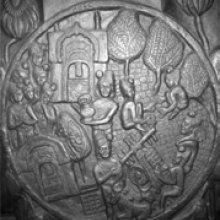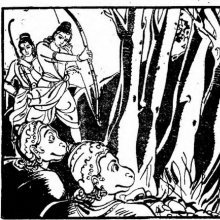Tree: 5 definitions
Introduction:
Tree means something in Hinduism, Sanskrit, the history of ancient India. If you want to know the exact meaning, history, etymology or English translation of this term then check out the descriptions on this page. Add your comment or reference to a book if you want to contribute to this summary article.
Images (photo gallery)
(+137 more images available)
In Hinduism
Shaktism (Shakta philosophy)
Source: Brill: Śaivism and the Tantric Traditions (shaktism)Worship of Trees formed a part of the Navarātra Tantric ritual (an autumnal festival of the warrior goddess Caṇḍikā).—The sixth (ṣaṣṭhī) and the seventh (saptamī) lunar days involve awakening the goddess in a bilva tree (bodhana), worship of goddess as Cāmuṇḍā and Kālī in the branch, summoning her nine radiations in nine leaves (navapatrapūjā/patrikāpūjā), enlivening an unfired clay image of the goddess (prāṇapratiṣṭhā).—Various 8th century sources refer to rituals such as the worship of trees, for example: Devīpurāṇa, Kālikāpurāṇa, Kṛtyakalpataru, Durgābhaktitaraṅgiṇī, Durgāpūjātattva, Durgāpūjāviveka, Bhadrakālīmantravidhiprakaraṇa in Sanderson (2007); account of the Durgā Pūjā in Kelomal, West Bengal (Nicholas 2013).

Shakta (शाक्त, śākta) or Shaktism (śāktism) represents a tradition of Hinduism where the Goddess (Devi) is revered and worshipped. Shakta literature includes a range of scriptures, including various Agamas and Tantras, although its roots may be traced back to the Vedas.
Natyashastra (theatrics and dramaturgy)
Source: Shodhganga: Elements of Art and Architecture in the Trtiyakhanda of the Visnudharmottarapurana (natya)Trees (as found in nature) were commonly seen as a source of materials for Garments and Ornaments (in Indian Dramas), as conveyed through the Alaṃkāra division of Āhāryābhinaya: one of the four divisions of Abhinaya or “ways to convey or represent one’s emotion to others”, according to the Viṣṇudharmottarapurāṇa, an ancient Sanskrit text which (being encyclopedic in nature) deals with a variety of cultural topics such as arts, architecture, music, grammar and astronomy.—In the Sanskrit dramas ornaments like ear-rings, bracelets, head-gears etc. are seen to be collected from nature. This is informed in many of the Sanskrit dramas. In the Abhijñānaśakuntala, as for example, Śakuntalā is seen to wear flowers, leaves etc. as her ornaments. She is also seen to remain dependant upon nature for her garments. She was wearing the skin of tree as her daily garment. Her clothes were supplied by trees.

Natyashastra (नाट्यशास्त्र, nāṭyaśāstra) refers to both the ancient Indian tradition (shastra) of performing arts, (natya—theatrics, drama, dance, music), as well as the name of a Sanskrit work dealing with these subjects. It also teaches the rules for composing Dramatic plays (nataka), construction and performance of Theater, and Poetic works (kavya).
Shilpashastra (iconography)
Source: Shodhganga: Elements of Art and Architecture in the Trtiyakhanda of the Visnudharmottarapurana (shilpa)Trees refers to class of natural objects and phenomenon which follows specific guidelines in the tradition of ancient Indian Painting (citra), according to the Viṣṇudharmottarapurāṇa, an ancient Sanskrit text which (being encyclopedic in nature) deals with a variety of cultural topics such as arts, architecture, music, grammar and astronomy.—The Viṣṇudharmottarapurāṇa bears an elaborate description on the process of making the picture of some natural objects and phenomenon, e.g., Trees. Accordingly, the picture of mountain should be adorned with plenty of rocks, peaks, metals, trees, streams and snakes. The picture of forest is filled with trees, birds and wild beast. The picture of Vasanta i.e., the spring season should contain the trees which bloom in this season particularly, [...]. The picture of Varṣā i.e., the rainy season which is also known as monsoon period should be portrayed with the picture of birds hiding in the trees to get rid of rain, [...]. Thus, the Viṣṇudharmottarapurāṇa addresses various elements of nature, such as a Tree, since painting has much connection with time, mood and activity.

Shilpashastra (शिल्पशास्त्र, śilpaśāstra) represents the ancient Indian science (shastra) of creative arts (shilpa) such as sculpture, iconography and painting. Closely related to Vastushastra (architecture), they often share the same literature.
India history and geography
Source: Google Books: Manthanabhairavatantram (history)Trees, forests and groves close to human settlements have been venerated throughout the subcontinent up to the present day as the abodes of deities and a range of supernatural beings. References to these beings, of which the most well known type is the Yakṣa and his mate the Yakṣiṇī, are common in early Buddhist and Jain literature. They are well known to art historians also. The Barhut Stūpa and other early Buddhist monuments abound with their images. The earliest standing statue carved in the round so far recovered is the famous Pārkham’s Yakṣa preserved in the museum at Mathura. It was probably made in the third century BCE and may well have stood under a tree.
Note: A distinction may have to be made not only between the concept of the tree itself as divine and the spirit supposed to be residing in it, but also, with respect to the latter, amongst the spirits of the trees in general, of particular trees close to habitation areas, of trees in a grove or forest, and of the spirits of groves and forests as a whole.—(Cf. Tiwari, 1985:21)
Source: Suomen Antropologi: Sacred Trees among the Tamil people of South IndiaTrees and Groves (in ancient India) were worshiped for their auspiciousness and the numerous benefits derived from them in the form of food, fodder, medicine and firewood.—The shrines of the guardian deities are commonly situated at the entrance of a village. At the core of a shrine there is usually a sacred tree, most often an indigenous species such as a Bodhi (Ficus religiosa), a Banyan (Ficus benghalensis), or a Neem (Azadirachta indica). If the village guardian is male, an image made of stone or clay resides under the tree, sheltered by stone walls and a roof.
There is a particular pattern that gives a Tree the status of sanctity. First, a deity that has chosen a certain tree as his/her residence contacts a villager (male or female), who is generally known for his/her purity and spiritual sensitivity. [...] The narrative connected to the history of a sacred tree and the founding of the shrine or temple is repeated over generations among the villagers. In the process of succession, old trees or patches of forests degrade naturally and the new growth inherits their sanctity: the older a sacred tree or grove, the stronger the accumulation of prayers and rites, even if the original trees have been naturally replaced by new growth several times. With the age the sanctity increases correspondingly.

The history of India traces the identification of countries, villages, towns and other regions of India, as well as mythology, zoology, royal dynasties, rulers, tribes, local festivities and traditions and regional languages. Ancient India enjoyed religious freedom and encourages the path of Dharma, a concept common to Buddhism, Hinduism, and Jainism.
See also (Relevant definitions)
Starts with (+34): Tree alfalfa, Tree aloe, Tree aralia, Tree bean, Tree calabash, Tree celandine, Tree cotoneaster, Tree cotton, Tree cotton of india, Tree cranberry, Tree crinum, Tree dracaena, Tree euphorbia, Tree fern, Tree fuchsia, Tree gousiekte, Tree grape, Tree heath, Tree heliotrope, Tree hibiscus.
Ends with (+774): Abyssinian myrrh tree, Acacia tree, Adike tree, African catechu tree, African locust bean tree, African mahogany tree, African myrrh tree, African tulip tree, Almond tree, Almondette tree, Amboina pitch tree, American plane-tree, Amur cork-tree, Ana tree, Angelica tree, Angelin tree, Ant tree, Arar tree, Arartree, Arn tree.
Full-text (+14818): Vriksha, Ashvattha, Jambu, Kadamba, Udumbara, Vata, Palasha, Kalpavriksha, Bilva, Druma, Panasa, Amra, Nimba, Khadira, Shala, Madhuka, Vanaspati, Candana, Nyagrodha, Parijata.
Relevant text
Search found 475 books and stories containing Tree; (plurals include: Trees). You can also click to the full overview containing English textual excerpts. Below are direct links for the most relevant articles:
The Skanda Purana (by G. V. Tagare)
Chapter 252 - Greatness of Trees < [Section 1 - Tīrtha-māhātmya]
Chapter 247 - Greatness of Aśvattha Tree < [Section 1 - Tīrtha-māhātmya]
Chapter 1 - Increase in the Height of Vindhya < [Section 1 - Pūrvārdha]
Brihat Samhita (by N. Chidambaram Iyer)
Chapter 59 - On entry into the forest (vanasampraveśa or vanapraveśa)
Chapter 55 - On Gardening (vṛkṣāyurveda)
The Padma Purana (by N.A. Deshpande)
Chapter 58 - In Praise of Planting Trees etc. < [Section 1 - Sṛṣṭi-khaṇḍa (section on creation)]
Chapter 28 - The rite (vidhi) of planting of trees (pādapa) < [Section 1 - Sṛṣṭi-khaṇḍa (section on creation)]
Chapter 102 - Aśokasundarī is Born < [Section 2 - Bhūmi-khaṇḍa (section on the earth)]
Manusmriti with the Commentary of Medhatithi (by Ganganatha Jha)
Verse 8.285 < [Section XLII - Assaults]
Verse 5.6 < [Section II - Objectionable Food]
Verse 6.26 < [Section III - Details of the Hermit’s Life]
The Agni Purana (by N. Gangadharan)
Chapter 282 - Description of Horticulture (vṛkṣāyurveda)
Chapter 247 - The characteristics of a site for Building (vāstu-lakṣaṇa)
The Markandeya Purana (by Frederick Eden Pargiter)
Related products
(+55 more products available)











